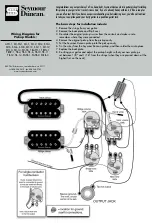
25
Phase shifting involves splitting the input signal into two signals, then shifting the
phase of different frequencies of one signal before mixing it back with the original signal.
The PARAMETER SELECT control will allow you to access each of the following
Phaser parameters:
Functions and Parameter Descriptions
PHASER
Function
PHASER I/O
PSR PAN
PSR DEPTH
RATE
P>RESONANCE
PSR STAGES
TIME
PHASER LVL
The PHASER I/O parameter determines whether the phase shift circuit is
active or bypassed for the current preset.
The PHASER PAN parameter allows you to pan the phase shifted
signal to the left or right channel by any amount.
The PHASER DEPTH parameter determines the modulation depth of
the phase shift effect. Higher parameter settings result in the sweep of
the filtering effect occurring over a wider frequency range.
The RATE parameter determines the speed at which the phase shifted
signal is modulated.
The PHASER RESONANCE parameter adds feedback to the Phaser so
that it has a more pronounced effect.
The PHASER STAGES parameter determines how many stages of
phase shift are to be active. A parameter setting of "4" produces a result
similar to a vintage Phase 90, while a setting of "6" emulates other
common phaser pedals.
The TIME parameter determines the multiplier by which a new
modulation rate will be selected for the RATE parameter when the Tap
Delay feature of the MultiValve is used. (See Section 7: "Tap Delay" for
more information on the Tap Delay feature.)
The PHASER LEVEL parameter allows you to control the level of the
phaser signal at the output of the MultiValve relative to the direct signal
and other effect signals.
Summary of Contents for MULTVALVE
Page 11: ...8 5 Connections Using the MultiValve within a guitar rack system ...
Page 12: ...9 Using the MultiValve in a preamp effects loop ...
Page 13: ...10 Using the MultiValve with a mixing console Connections ...
Page 15: ...12 Classic Configuration Block Diagram Block Diagrams ...
Page 16: ...13 Rotary Configuration Block Diagram Block Diagrams ...
















































